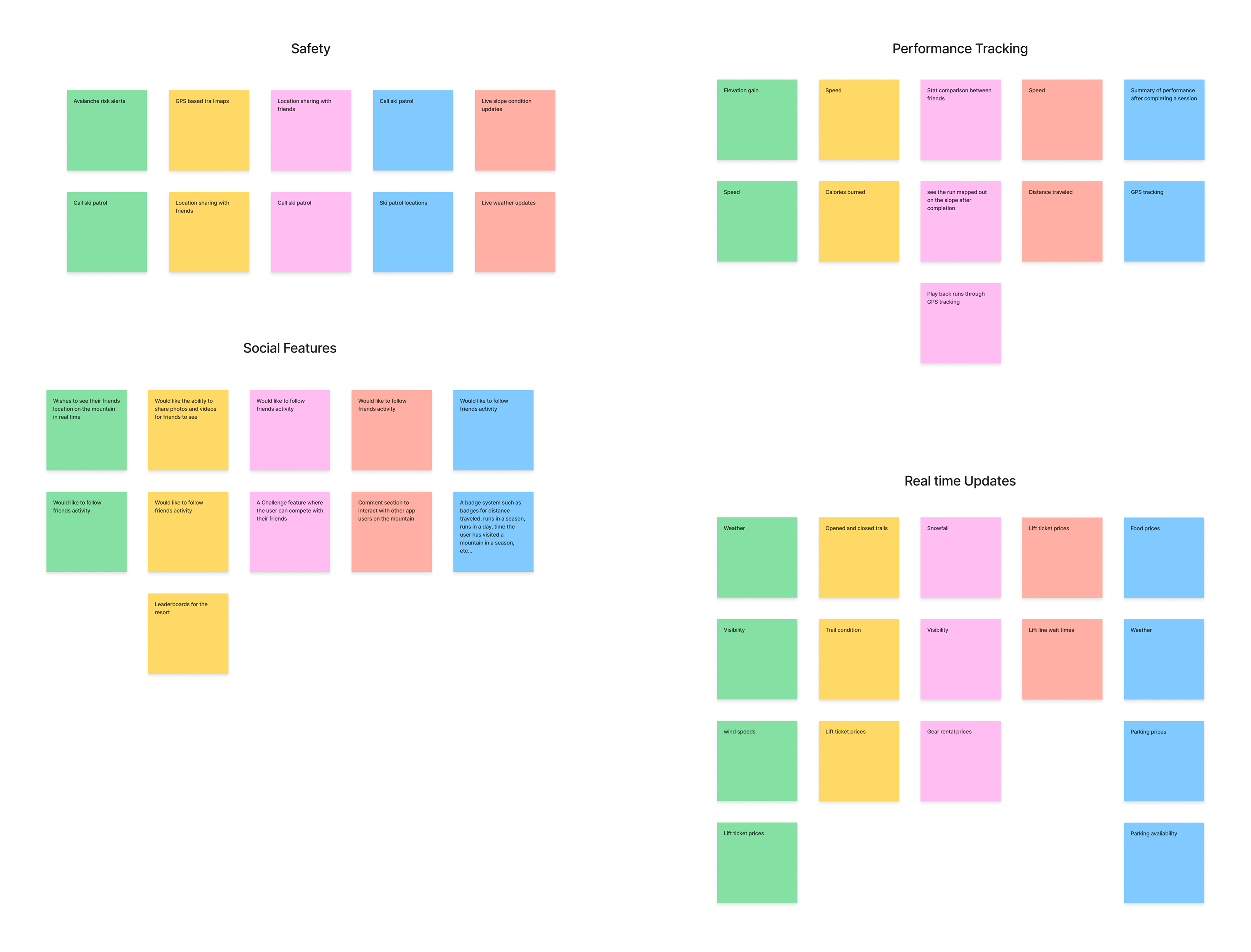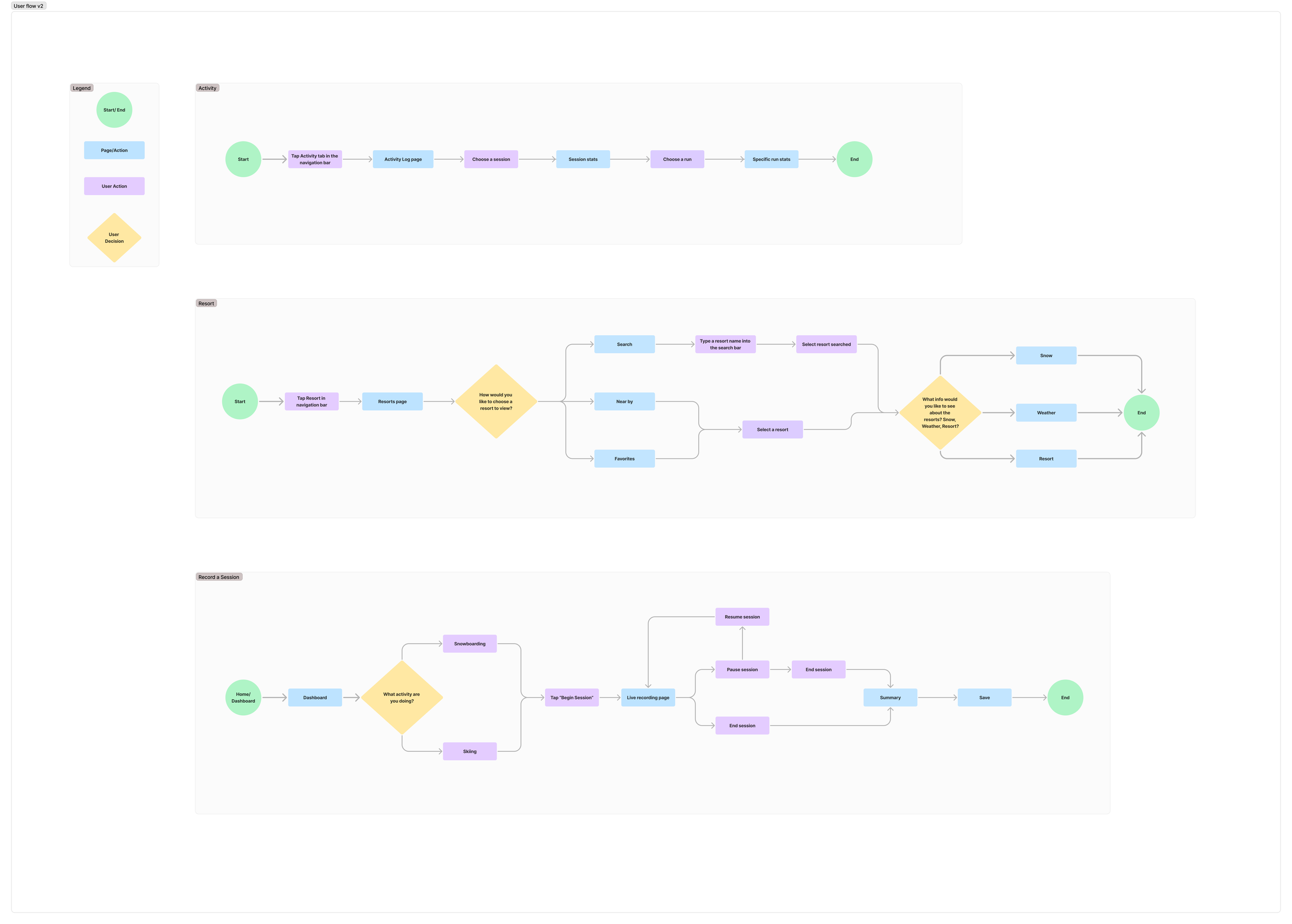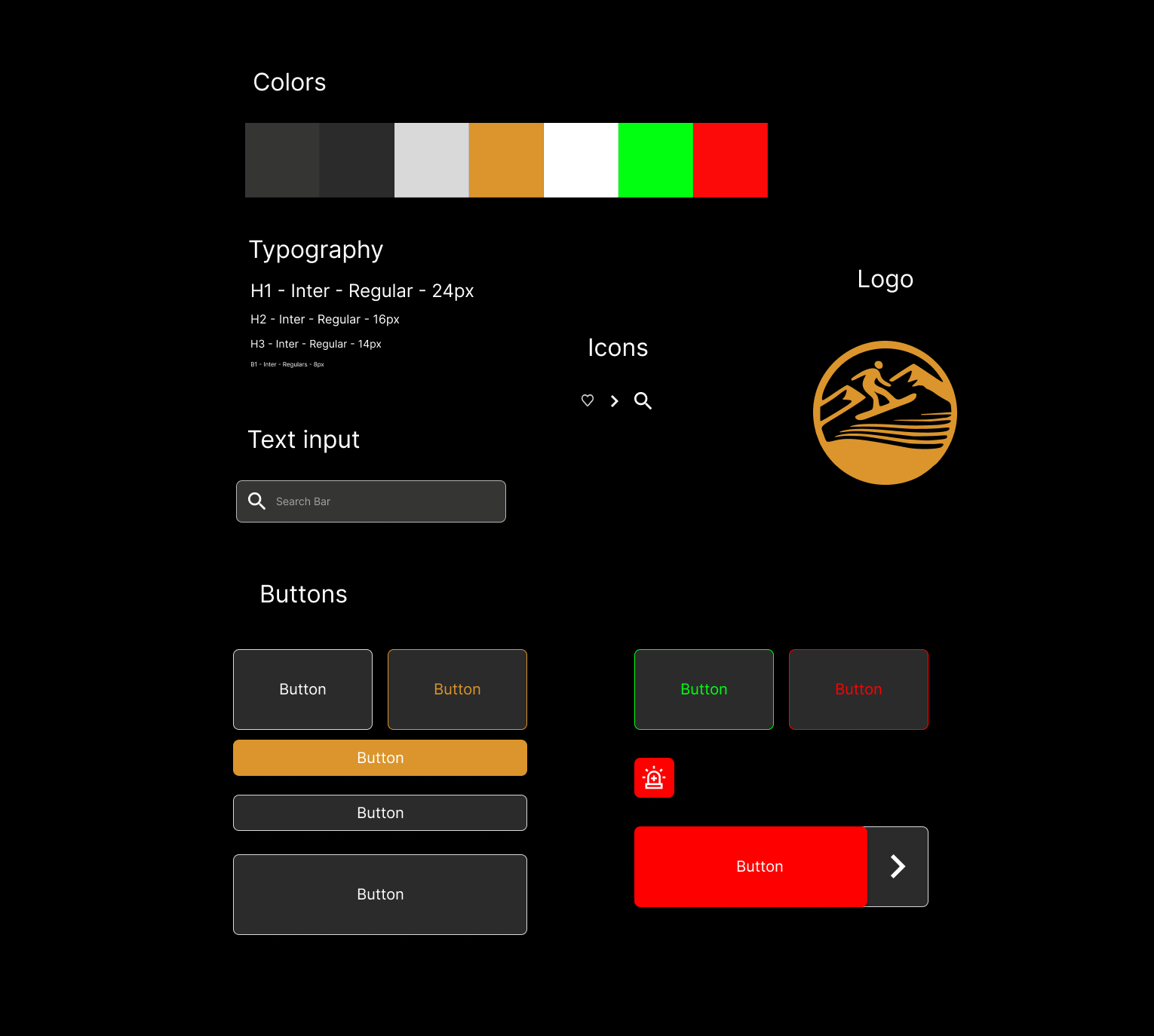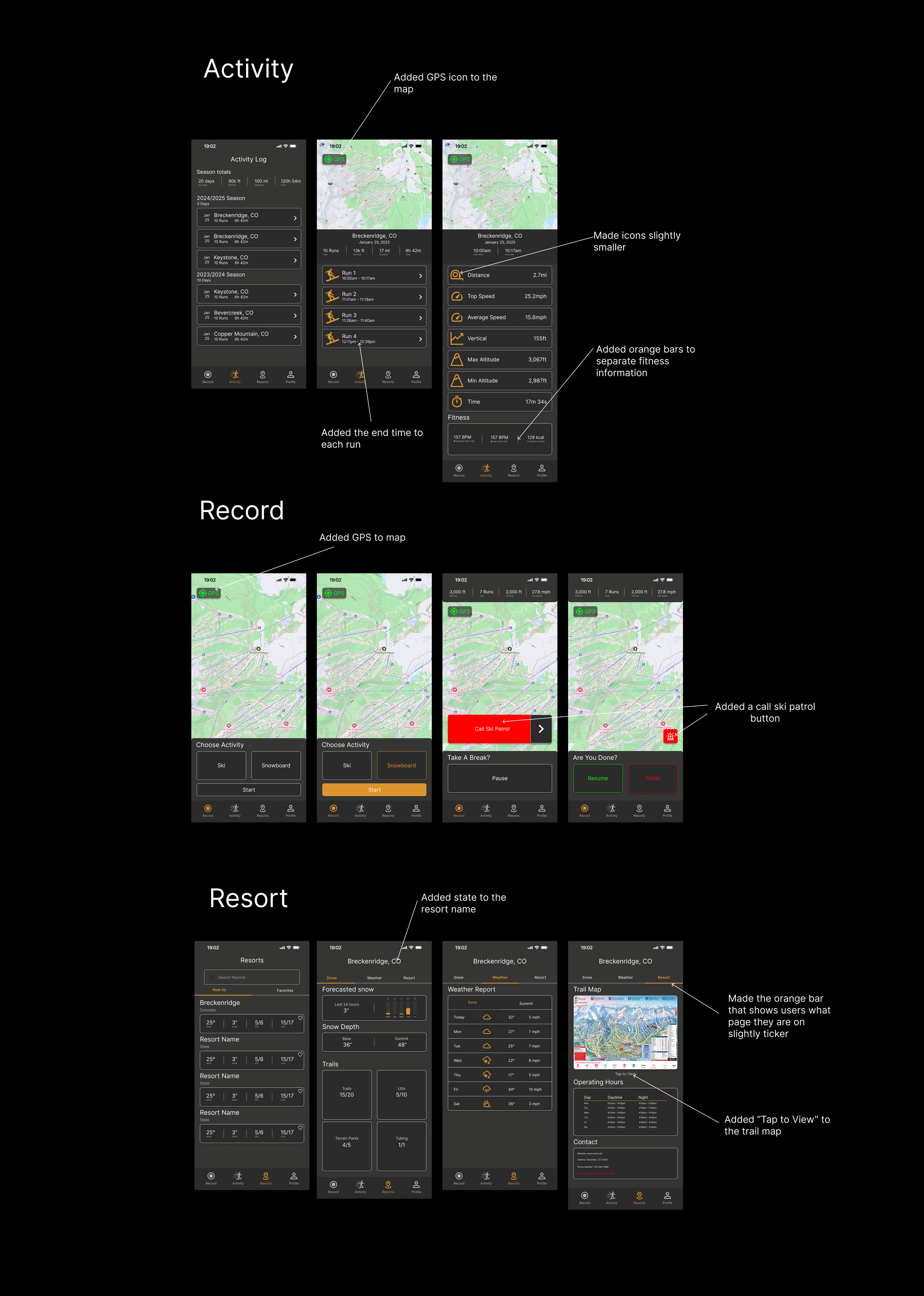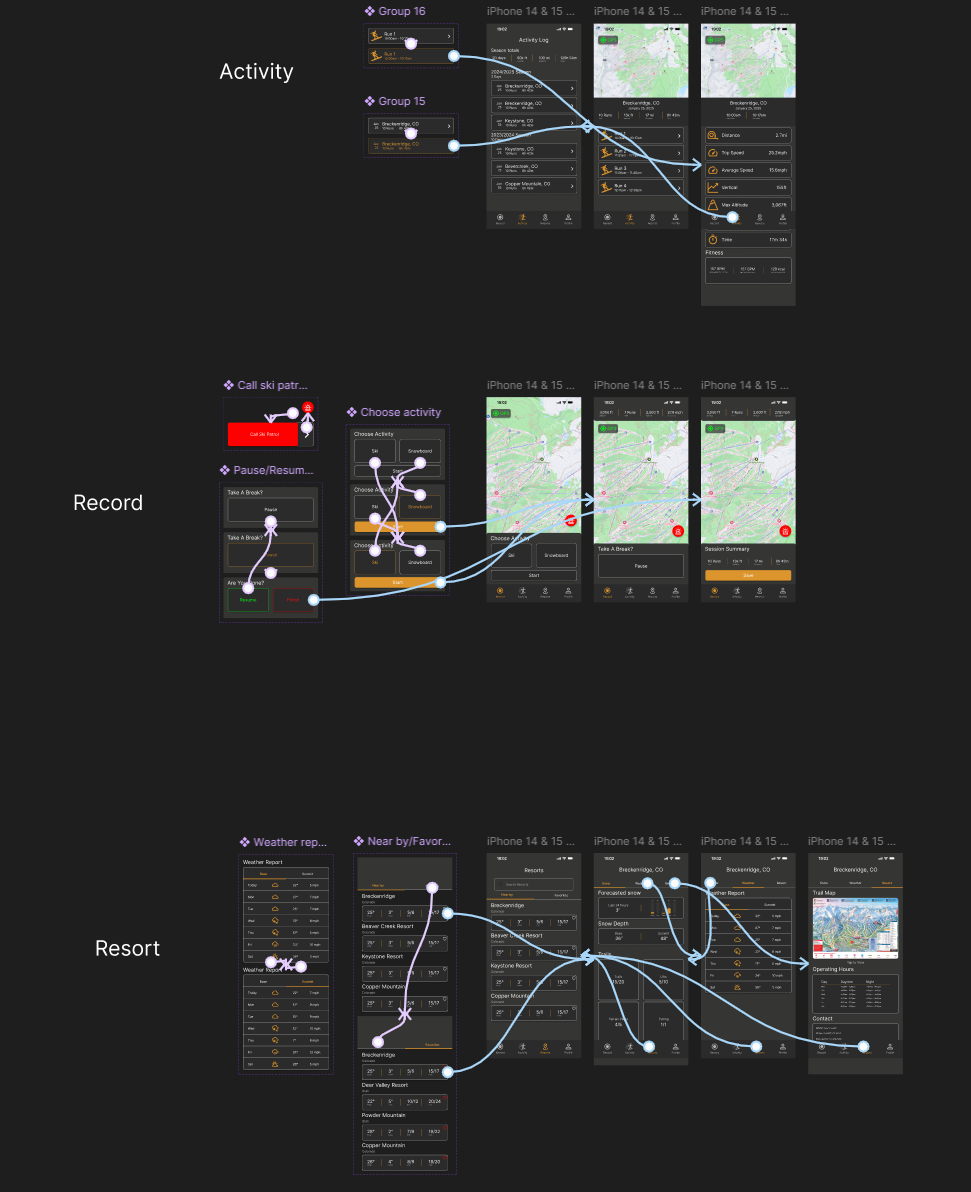ShredTrack
Explore how I designed an intuitive data driven app that that empowers riders with performance metrics, real-time weather updates, and real-time resort updates by blending a user friendly design with powerful analytics. ShredTrack helps riders push their limits and make the most out of every run.
Overview
Skiers and snowboarders often struggle to find a convenient solution that allows them to track their performance on the slopes. As well as access to accurate data, real time weather updates, and slope conditions. Switching back and forth between multiple platforms to plan for trips and track progress is a common occurrence. This can lead to poor trip planning, safety risks, and missed opportunity to track improvements in performance.
Objective
To create a seamless design that allows users to track their ski runs and see real time updates to weather and slope conditions.
1
Create a user friendly UI
A user friendly UI for skiers and snowboarders should focus on clear and simple interactions, ease of use, and visibility in challenging conditions
2
Empower riders with performance metrics
Make the data meaningful, actionable, and easy to understand
3
Realtime weather and slope condition updates
Focus on creating timely, relevant and actionable information that enhances the users experience and helps them to make informed decisions
Exploring the Landscape
I began by conducting competitor analysis to identify existing gaps in the current ski/snowboard tracking apps on the market.
To better understand the landscape, I analyzed three major competitors in the snowboard tracking space
OnTheSnow Ski and Snow Report
Slopes
Carv
While each app included some but not all of these key features.
Real time feedback
post session analytics
live resort data
live weather updates
offline functionality
safety features
social features.
A space where users can have an all in one experience of these essential features is not readily available
Objective
To gain insight on users behaviors, expectations, and pain points of skiers and snowboarders and discover what enhances user experience on the slopes.
5 participants recruited
Key learnings
Safety is a number 1 priority for all participants.
Skiing and snowboarding are sports that have their risks and having the proper features to keep users safe is key.
Although each participant has varying levels of experience they all seemed to see the benefits in using an app while on the mountain.
Even those who only go 1-2 times a year enjoyed the idea of an app to track their progression.
Real time updates on slope conditions, weather, open and closed trails seemed to be common among participants in what they would like in an app.
Although 1 participant mentioned they did not care for social features in the app, social/community features were positive with either 4 participants.
Being able to follow friends and see each other's stats was the main social feature mentioned.
It seems that a few of the participants like the competitive aspect of beating each other's stats. Other secondary features that the participants seemed to like was real time information on lift tickets, parking, lodging and gear rentals.
Having smartwatch integration seemed key because using a smart watch during an activity like skiing or snowboarding seemed to be the most convenient way to use an app while on the slopes for most users
Listening to Riders: Insights from User Interviews
Through user interviews, I gathered valuable insights directly from skiers and snowboarders of varying skill levels.
Many riders expressed a desire for real-time, easy-to-read performance data, emphasizing that simplicity and speed were key for them on the slopes.
Common themes also included the need for weather and slope condition updates, as well as incorporating safety features.
These findings helped me prioritize essential features and design an app that truly meets the needs of its users.
The information gathered was compiled into an affinity map to group patterns between participants
What Riders Told Us
Understanding the Rider: Crafting a User Persona
I then created a user persona that embodies real user characteristic. This persona heled guide design decisions ensuring the app would meet the unique needs of all types of riders
Defining the Problem
From the insights and after defining the primary persona, it was clear the top 3 problems were
1
Rider struggle to track their stats accurately during skiing and snowboarding session
2
Skiers and snowboarders often face the risks of getting injured, lost, or without a reliable way to call for help in emergency situation
3
Skiers and snowboarders find it challenging to see real time updates on weather conditions, trail closures, and lift status updates.
However, I felt the main problem to focus on was riders struggling to track their stats accurately as that would be the simplest problem to solve yet the problem to deliver more value to the user, as they experienced it regularly.
Turning Challenges into Opportunities - How Might We…
1
How might we accurately track rider stats in real time even while the user is offline or in places of poor connectivity?
2
How might we make it easy for users to call for help? How might we use GPS for users to see and share their location on the slopes?
3
How might we create a way for users to access real time resort information?
Defining Success - Project Goals
Business Goals
The app aims to fill a gap in the snowboard tracking market by offering a seamless, user-friendly experience that keeps riders engaged. By providing valuable insights, social sharing features, and accurate real-time data, we strive to build a loyal user base, drive app adoption, and create opportunities for partnerships with resorts and gear brands.
User Goals
Riders need a simple yet powerful way to track their performance, monitor real-time weather and slope conditions, and set personal goals. The app should enhance their experience on the mountain, providing insights that help them improve while remaining easy to use, even in cold conditions.
Technical Considerations
The app must deliver real-time tracking with high accuracy, function in offline environments, and integrate seamlessly with wearables and smart devices. It should also be optimized for battery efficiency, perform well in extreme weather, and have a scalable architecture for future feature expansion.
Mapping the Experience: Site Structure and Navigation
A site map was then used to define key areas of the application, ensuring a logical flow and easy access to important functionalities
Site map V1
The first iteration of the app included 4 main pages. Safety, resort, friends, tracking/stats.
The second and final iteration reprioritized the structure of the app and created new pages. Record, Activity, Resorts, and Profile.
This simplified the design while prioritizing key features and leaving room for lower priority features to be added later on
Design - Site Map V2
Seamless Navigation -Understanding the User Flow
A user flow was then created to visually represent the steps a user will take to accomplish a specific task
User flow V1
The first iteration of flows included Safety features, Stats summary, and Record a session
Due to the priority changes made to the site map, the user flows then followed in iterations.
The 2 new flows added were Activity and Resort.
Record stayed with minor change at the end of the flow where the user can view a summary of their session before saving their stats
User Flow V2
Laying the Foundation - Low Fidelity Mockups
Early stage designs were then mocked up to outline the basic structure and layout of the app
The brand created was to engage users, both causal and experienced. I wanted the user to feel warmth and friendliness and well as a sense of adventure.
Enhancing visibility in snowy or outdoor conditions was a key player in the color choices
Defining the Look & Feel: Crafting the Brand Identity
Bringing the Vision to Life: High Fidelity Mockups
A detailed and polished representation of the app was then created. This showcased the final visual design elements assisting in bringing the concept to life
Refining the Experience - Usability Testing
Conducted with 5 participants who have varying experience skiing and snowboarding.
The goal was to evaluate how easy and intuitive the app is for users to navigate and accomplish tasks.
Evolving the Design - Iterations and Refinements
Record
GPS icons were added to the map
An emergency/call ski patrol button was added
Resort
The state name was added to the resort name
Orange bars were made slightly thicker so that it was more clear to users what page they were on
“Tap to View” was added to the trail map
Activity
GPS icons were added to the map
Icons on the 3rd screen were made slightly smaller
Orange bars were added to divide up fitness stats
The end time was added to each run on the second screen
A preliminary version of the app was created to visualize the functionality of the design. This prototype takes users through the 3 flows of Activity, Record, and Resort
From Concept to Interaction
ShredTrack was developed to address the unique needs for skiers and snowboarders. ShredTrack provides an all in one comprehensive platform that enhances ther user experience on the slopes. The goal was to create a space where users can track performance, personal progression, and gain access to real time weather and resort updates. This app aims to the be the one stop solution for both beginners and advanced riders helping them maximize their time on the slopes
Next Steps
There are plenty of feature I would like to explore in the future with this design to make the app more useful and engaging for users. Some additional features include
Run playback
Challenges/Leaderboards
Community features (Adding friends, sharing location, content sharing)






